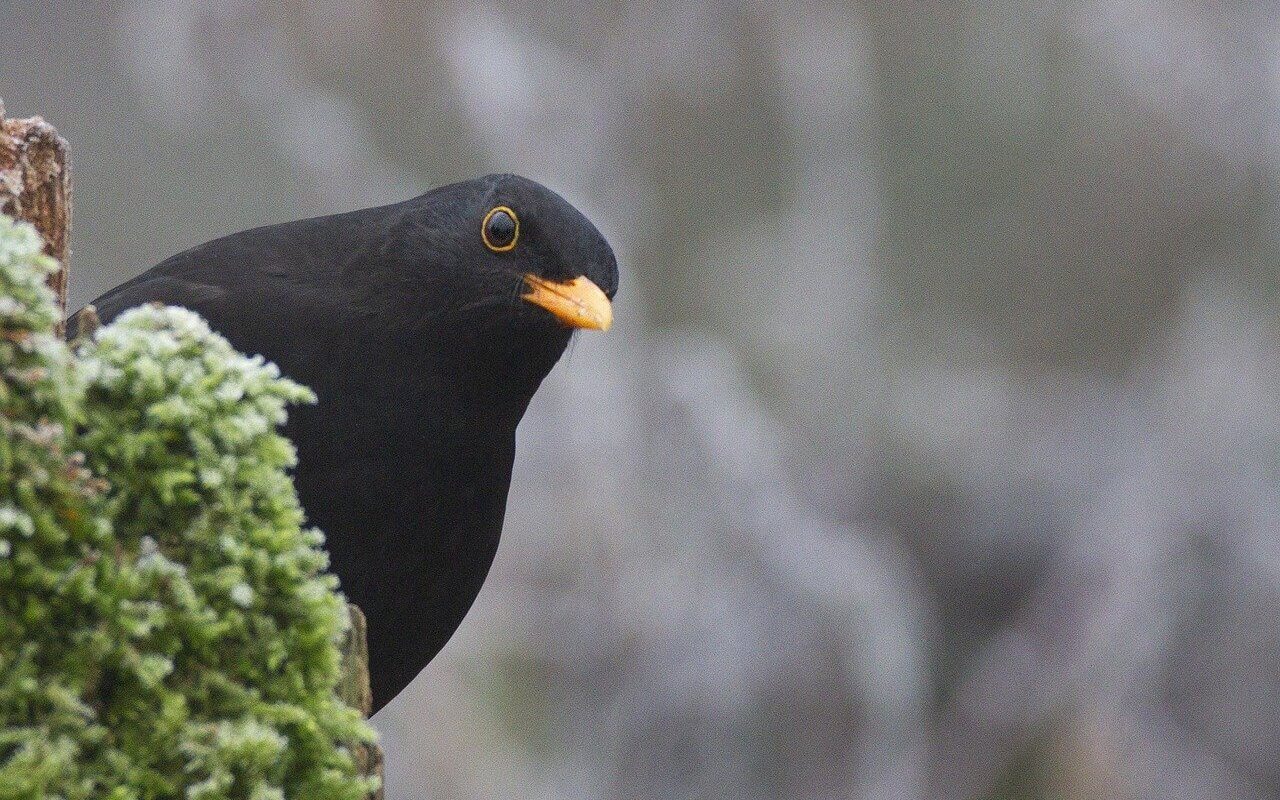As you sit and sip your coffee – you may have noticed an unfamiliar visitor in your garden. Is that a blackbird with a yellow beak? This combination of colors is not particularly rare amongst birds common to the USA, so I’ve put together this guide to help you identify your new avian friend.
A blackbird with a yellow beak in your garden could be a Thrush, Myna, Starling, Blackbird, or Scoter. Other birds with this particular combination but less likely to be found in a residential area include Black and White Owls, Black Hawks, and Cormorants.
In the rest of this article, I will dive into more detail about these beautiful birds, including how to tell them apart, where they tend to live, and their particular personality traits.
Binoculars ready? Let’s go!
Recommended Birdwatching Equipment:

|
Check Here (on Amazon)
|

|
Check Here (on Amazon)
|
|
Check Here (on Amazon)
|
A Black Bird with Yellow Beak?
When identifying a blackbird – it’s important to keep in mind the following five things:
- The size of the bird – is it small, medium, or large?
- The plumage – do black feathers cover its whole body? Or are there flashes of white or gray?
- The shape of its beak – is it small and in proportion to the head? Or long and thin? Is it straight or curved?
- The habitat you are observing in – is the bird on or around water, swooping through a forest, or in your own backyard?
- The season – birds move around during the year. And many birds have subtly changing plumage and beak coloring across different seasons.
In this article, I will help you tell apart the Blackbird and Thrush, the Magpies, and Myna. I’ll start this list with the birds you are more likely to find in a residential area before moving on to identify some birds with a more specialized environment.
1. Black Thrush
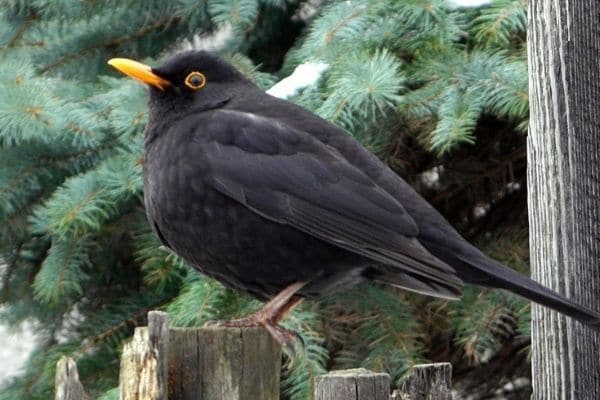
The Black Thrush, or Turdus infuscatus, used to be known as the ‘black robin.’ Although it is true that only the males have the black plumage and yellow beak, these features are very distinctive.
Their feathers are a deep, solid black color with no oily or blueish undertones. Their beaks are bright sunshine yellow and match their equally bright yellow eye-rings and yellow legs.
These are medium-sized birds with relatively short tail feathers and a beak well-proportioned to their heads. By contrast, the female Black Thrush has a browner plumage, and her beak is black.
Watch this YouTube Video to hear the songs and calls of the black bird:
The Black Thrush are native to the warm and humid climates of Central America and Mexico but, over the years, have begun a steady northbound migration.
They feed off fruits and other vegetation from the treetops, plus small insects, worms, and amphibians. You may find them in your garden, turning over the earth in search of a tasty worm or slug.
2. Yellow-Legged Thrush
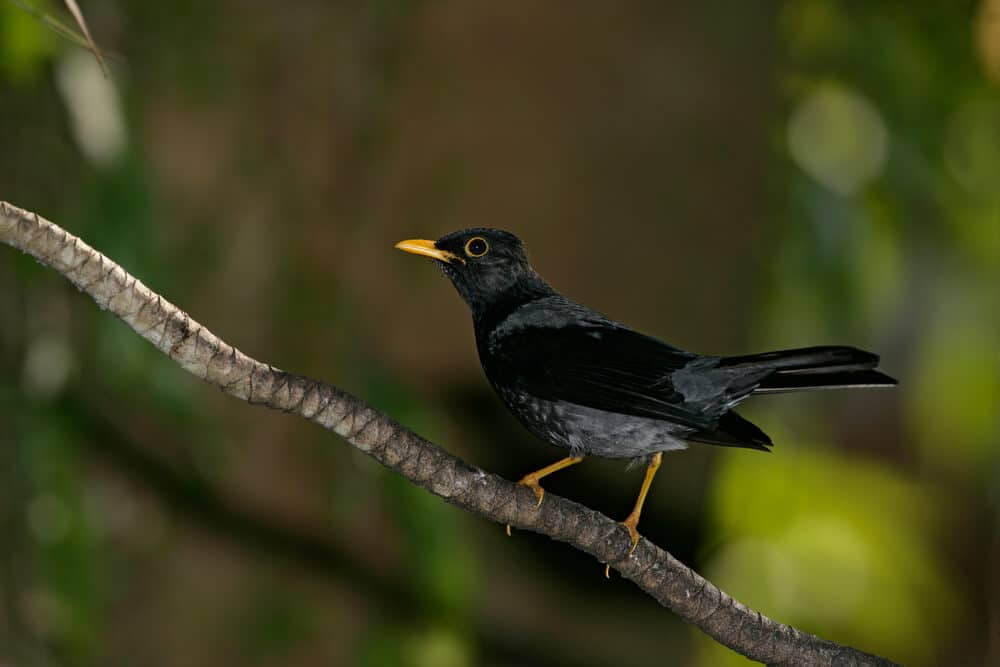
The Yellow-Legged Thrush, Turdus flavipes, is a similar size and shape to its cousin, the Black Thrush, but these elegant birds are identified by a slate-gray stripe that runs down their back and underside.
Apart from this, an adult male has mostly black coloring, a yellow beak, yellow eyerings, and darker orange legs. Females are a speckled brown color with a greyer underside.
These songbirds are native to North and East South America, where they live in temperate woodlands, preferably near a body of water. Due to changing climates and habitat destruction, they are becoming more common in residential areas of central and north America.
3. Common Myna
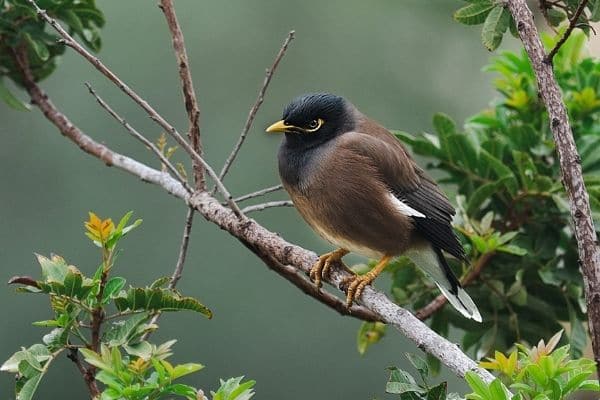
Although native to Australia and South Asia, the Common Myna has made its home all over the world – thanks to human intervention.
Nowadays, they are mostly found around Florida – but their spread across the USA is likely a matter of time. In fact, in the year 2000, the International Union for Conservation of Nature (IUCN) declared them to be one of the world’s most invasive species!
The Common Myna, Acridotheres tristis, are a large bird species – often measuring over 9 inches long and weighing between 110 and 140 grams.
Males and females look very similar, and both feature a dark brown body, completely black head, and yellow beak.
To be certain you are looking at a Common Myna, check for a small yellow mark around the back of their eye.
4. Hill Myna
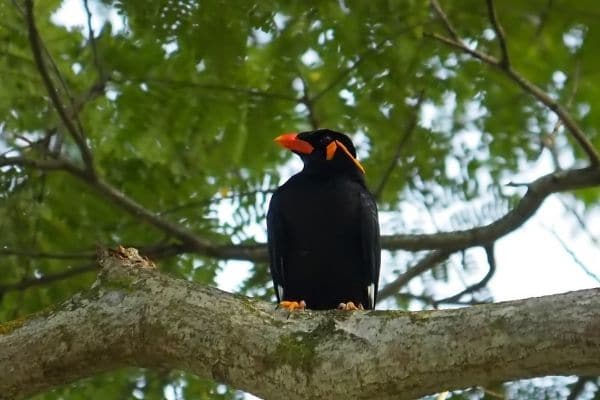
The Hill Myna, Gracula religiosa, goes by a few names. You may see it identified as the Common Hill Myna or simply as Mynah. All of these names describe the same creature – a bird with characteristic glossy black plumage, a yellow beak, and a yellow patch behind the eyes similar to that seen in the Common Myna.
To tell the two apart – look at how far around the head the yellow patch extends. If it stretches right around the back of the head and partly down the neck, then you are looking at a Hill Myna.
The Hill Myna also sometimes have a flash of white feathers at the tip of their wings, a trait not seen in the Common Myna. Their black feathers aren’t sooty, like other blackbirds, but have a lustrous sheen and purple overtone reminiscent of an oil spill.
These birds are native to Asia but were introduced to Florida around 1982, from where they have continued to spread across the USA.
These birds are comfortable around people and are noted for their intelligence and excellent mimicking skills – particularly the human voice. They have even been bred in captivity as pets!
5. European Starling

The European Starling, Sturnus vulgaris, are native to central Europe.
They were first brought to the USA in 1890 by a man called Eugene Schieffelin in his efforts to introduce every bird mentioned in the works of Shakespeare into North America.
Unfortunately for Schieffelin’s thespian efforts, they are now considered to be an invasive species and often out-compete other smaller birds for both territory and food.
European Starlings are medium-sized birds with a short tail, narrow beak, and salmon-pink legs. In the summertime, they have a glossy, softly speckled plumage that complements their canary yellow beak.
Their plumage has an iridescence to it – slight shadows of blue and purple can be seen shimmering in the light. In winter, their beaks darken and appear almost black.
These birds are migratory – during the summer months, they travel to northern territories, including large areas of Canada. If you think you’re seeing a European Starling, then pay attention to your location and the season!
6. Eurasian Blackbird

The Eurasian Blackbird, Turdus merula, or common blackbird is not to be confused with New World Blackbirds! Eurasian Blackbirds are medium-sized birds belonging to the Thrush family.
They can measure up to 10 inches from head to tail and have a wingspan of up to 16 inches.
Males are completely black but with a bright yellow beak and yellow eye-ring, whereas females are brown and have a duller beak and gentle speckling on their chest.
Males and females form a mating pair, with the males valiantly protecting their territory during mating season, which begins in March. These birds are beloved for their melodious song, as noted by The Beatles in their 1968 hit ‘Blackbird.’
By contrast – New World Blackbirds are not part of the Thrush family, are much smaller than Blackbirds, and are often found in a variety of bright colors, including red, white, and orange. Don’t be fooled by the similar names – these two birds couldn’t be more different!
7. Yellow-billed magpie
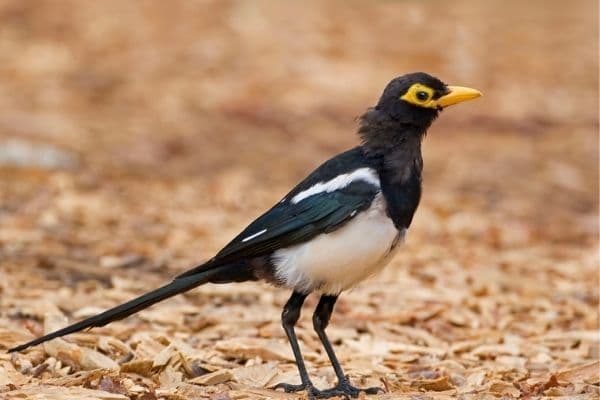
If you live in California – then maybe you have spotted a Yellow-Billed Magpie! The Yellow-Billed Magpie, Pica nuttalli, is a member of the Corvidae family, therefore, is a type of crow.
They are almost identical in appearance to their crow relatives apart from their bright yellow bill – a stark contrast to the inky black of their feathers – plus a yellow streak around the eye.
These medium-sized birds measure between 16-17 inches long, have a wingspan of up to 24 inches, and can weigh as much as 142g.
The intelligent Yellow-Billed Magpie is usually only seen in limited areas of California – running as far North as the Oregon border, where they eat carrion and the by-products of arable and animal agriculture.
Unfortunately, these beautiful birds are classed as vulnerable species due to their susceptibility to the West Nile virus. This disease was responsible for a loss of around 50% of the population between 2004 and 2006, but numbers are stabilizing and may yet recover.
You May Also Like To Read: Black Birds With White Bellies
8. Black scoter
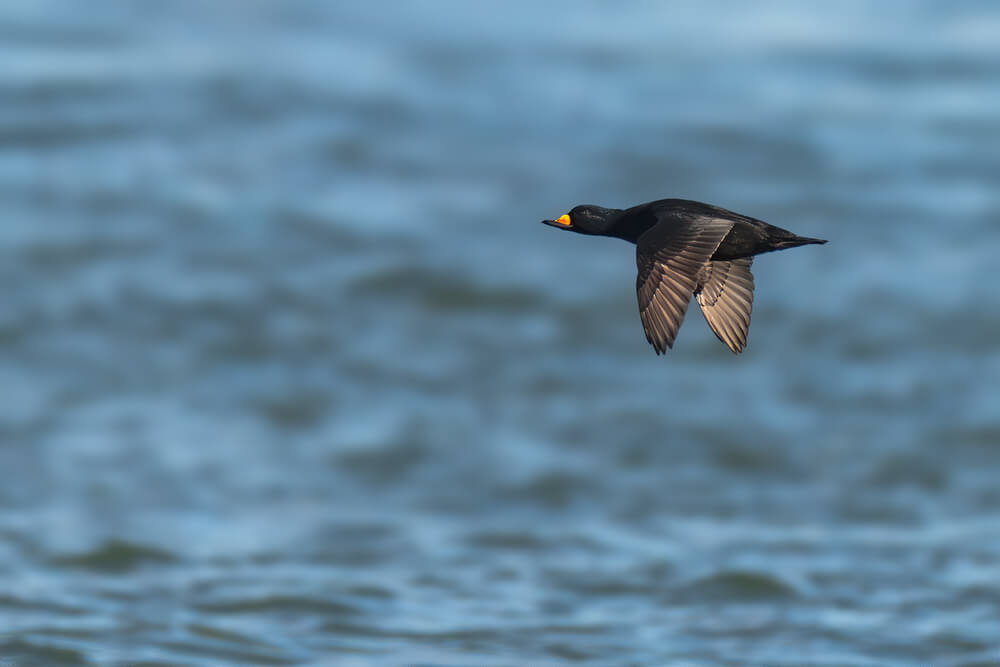
Now I have covered some of the more common birds you may have spotted – it’s time to look at the more unusual black birds with yellow beaks.
The Black Scoter, Melanitta americana, – also known as the American Scoter – is a large sea duck native to North America.
These impressive sea-faring birds are recognizable by their fully black feathers, chunky body shape, and bulbous yellow beaks.
They can measure up to 22 inches long with a 28-inch wingspan and weigh just over 2 pounds. Female Black Scoters are slightly smaller than their male counterparts and look more similar to the Common Scoter, with brown plumage and pale feathers along the side of the head.
The Black Scoter feeds on aquatic organisms, including small crustaceans, mollusks, and fish eggs. When they settle in freshwater, they have also been seen eating insect larvae and pondweed.
If you spot a Black Scoter, you are in luck – they are currently classified as Near Threatened by the IUCN.
9. Great Cormorant
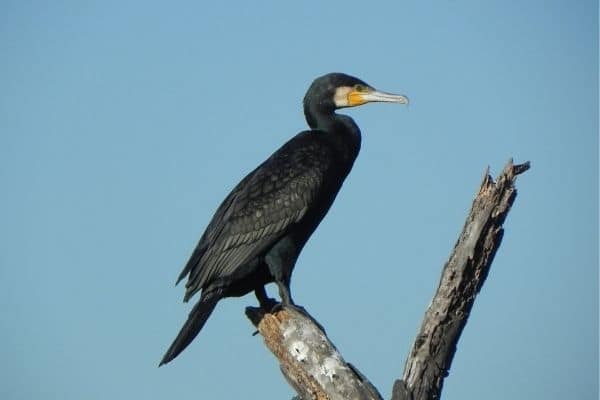
The Great Cormorant, Phalacrocorax carbo, is another large black seabird – dwarfing the Black Scoter with an impressive maximum length of 40 inches from head to tail and a wingspan up to 63 inches across.
These huge birds have an inky black plumage with soft speckling across the outer side of their wings. Their beaks are a muddy yellow color and feature a short but severe curve at the tip. They have large black legs and strongly webbed feet.
The Great Cormorant loves to sit in a sunny spot by its watery habitat and spread its wings out in the sun. You may see them holding this pose for a long time as they dry out their feathers after a session of fishing. They are found along the east coast of the USA.
As a testament to the Great Cormorant’s excellent fishing skills, they have been hunted to near extinction in the past, especially in areas where humans depend on fish for food. In fact, since about 600 CE, Cormorant Fishing has been practiced in Japan and China, where humans have trained the birds to fish.
10. Black Oystercatcher

The Black Oystercatcher, Haematopus bachmani, can be found all along the western coastline of North America, from Alaska to California.
These birds are hard to mistake for anything else – they are funny to look at with their round, streamlines bodies, long yellow legs, and brightly colored yellowy-orange beaks.
Their plumage is completely black, almost sooty, in color, and appears darker the further North the birds are residing. You will most commonly find these birds picking along the seashore, turning over stones and vegetation to uncover their meal of mussels, limpets, and small crabs.
11. Common Black Hawk
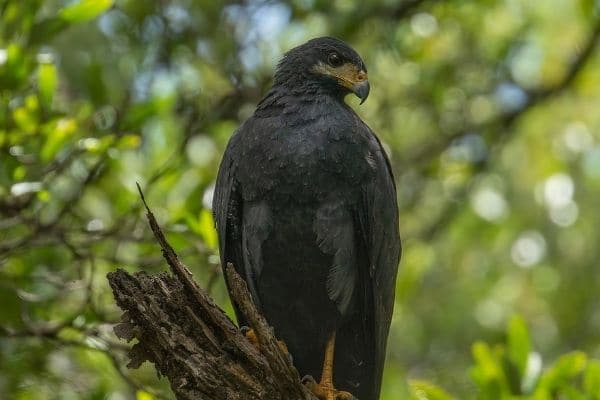
We finish our list today with a bird of prey – the Common Black Hawk, Buteogallus anthracinus, which heralds from the Accipitridae family. Although not especially common in the USA – you may be lucky enough to spot one in the Southwest – along a stream in a remote woodland or even in a canyon.
These dramatic hunting birds have a massive wingspan, up to 50 inches across, and feature a mostly dusty black plumage apart from a white band around their short tails. Their beaks are a dirty yellow color with a grey, sharp tip, and their legs are bright yellow.
As you would expect for such a dramatic bird – the Common Black Hawk feeds on small vertebrates, including mice, rats, and small rabbits. When they are hunting by water, they will pick up fish and crabs.
Do All Black Birds Have Yellow Beaks?

You may have looked through this list and reached the conclusion that all blackbirds have yellow beaks – but that isn’t the case. The crow family, the home of our friend the Yellow-Billed Magpie, is mostly made up of blackbirds with black beaks.
This charismatic class of birds includes Ravens, Rooks, and Jackdaws – all of which have completely black plumage and large black beaks. Even the cousin of the Yellow-Billed Magpie, the Pied Magpie, has dramatic black and white plumage and a black beak.
Other blackbirds include the Eurasian Coot – a water bird with black plumage but a brilliantly white beak and matching crest.
Do Any Crows Have Yellow Beaks?
Of course, the Yellow-Billed Magpie is one of the exceptions to the black beaked crow family, as is its close relative the Alpine Chough. The Alpine Chough, Pyrrhocorax graculus, is also known as the Yellow-Billed Chough, thanks to its cheerful yellow beak.
As the name suggests – these crow family members are native to the Alpine habitats of Southern Europe and can be found as far away as the Himalayas. They have glossy black feathers all over their body and head, a yellow beak, and red legs.
Why Do Black Birds Have Yellow Beaks?
Bird beaks are mostly made of keratin, a protein similar to that which makes up human nails and hair. If the layers of keratin lack any pigment, they are naturally a dull greyish-yellow color that darkens as the beak grows.
The yellow beaks of the birds I have described in this article get their colors from the inclusion of pigment in the beak structure. These pigments are called carotenoids, and their brightness can be influenced by the bird’s diet, general health, age, and the changing seasons.
Evolutionarily, the bright yellow beaks may have evolved as a social indicator to other birds of sexual maturity and strength. Many of the female birds from our list today have much duller beaks – indicating that the yellow color is used by males to attract a mate and ward off any would-be competition.
Final Thoughts
So – the next time you find yourself wondering as to the identity of a blackbird with a yellow beak – you will know to take into consideration its location, size, the seasons, and any particular behaviors you can observe.
A medium-sized bird of completely black plumage and a bight yellow beak is likely a member of the Thrush family and could be a Blackbird, Black Thrush, or Yellow-Legged Thrush. If the bird is slightly larger and has a distinctive yellow patch on its head, then it could be a Common Myna or Hill Myna.
If you find yourself birdwatching by a large body of water, then look out for the wing-spreading behavior of a Great Cormorant. If you catch sight of a slightly smaller bird prowling the shoreline, then you will know from the long, brightly colored beak that you are looking at a Black Oystercatcher.
Now you have read this article, and are familiar with the different black birds with yellow beaks, enjoy seeing which avian friends you can identify!
I think you’ll also like reading these ones…

